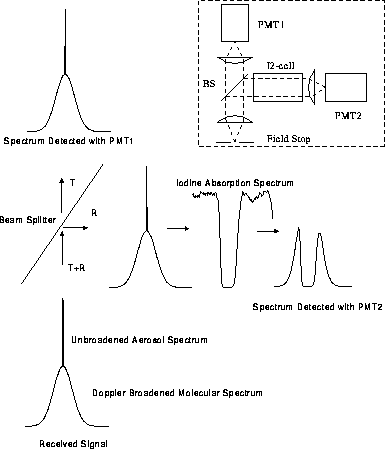Return to the Publications.
Return to the Index.
The decoupling of Equation 21 is possible because
the spectral response of a scattered photon is dependent upon
particle velocity. Molecules, mostly N![]() and
O
and
O![]() ,
move with a mean velocity proportional to
,
move with a mean velocity proportional to ![]() whose
distribution is represented by Maxwellian statistics; where T
is the temperature at a given range. Photons scattered from a molecule
will have their energy shifted, resulting in a symmetric Doppler pulse
broadening of the original
beam after a number of scattered photons return in a given range
bin. However, much larger, slower moving aerosols have a velocity similar
to the mean wind at a given range.
Therefore, aerosol backscatter exhibits negligible broadening with
respect to the original pulse due to the small vertical wind velocity
for a pulse propagating in the zenith direction.
whose
distribution is represented by Maxwellian statistics; where T
is the temperature at a given range. Photons scattered from a molecule
will have their energy shifted, resulting in a symmetric Doppler pulse
broadening of the original
beam after a number of scattered photons return in a given range
bin. However, much larger, slower moving aerosols have a velocity similar
to the mean wind at a given range.
Therefore, aerosol backscatter exhibits negligible broadening with
respect to the original pulse due to the small vertical wind velocity
for a pulse propagating in the zenith direction.
Figure 6 illustrates the spectral response difference between molecular and aerosol backscatter, and the technique utilized to separate the combined signals. The outgoing lidar pulse has a narrow linewidth. Aerosol backscatter is spectrally similar to the laser linewidth, whereas thermal broadening occurs with molecular scatter. An iodine absorption filter (Piironen, 1994) provides the bandpass necessary to spectrally filter the aerosol signal from the backscattered return.

Figure 6: HSRL two-channel technique, where molecular and aerosol
backscatter signal is separated with an iodine absorption
filter. A beam splitter transmits a portion of the return signal to
one channel, while the reflected portion is directed through the
iodine absorption filter and measured with a second channel. A
spectral calibration of the absorption filter allows direct measurement of
the individual aerosol and molecular backscatter signals. The insert
illustrates a schematic diagram of the HSRL instrumentation. Figure
used with permission (Piironen, 1994).
Using this approach, an ensemble of molecular backscattered photons can be differentiated from the aerosol return by a two-channel HSRL through spectral separation of the backscattered signal. One channel measurement represents a majority of the molecular signal, where the aerosol and a portion of the molecular signal has been effectively filtered from the detected signal. A separate channel simultaneously monitors the unfiltered backscatter, due to the combination of molecular and aerosol photons. The iodine spectrum is measured before data acquisition to deconvolve the data. A schematic diagram of the instrument is illustrated as an insert in Figure 6.